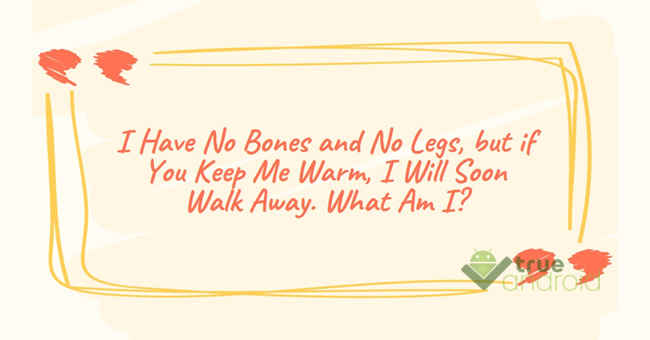This riddle offers a playful twist on familiar concepts, engaging the mind in a blend of science, logic, and wit. Let’s embark on a detailed exploration that divides our discussion into two parts: understanding the question and uncovering the answer.

Understanding the Question
At first glance, the riddle presents a paradoxical scenario—a creature or entity that lacks bones and legs, traditional prerequisites for mobility, yet promises to “walk away” if provided with warmth. This juxtaposition of immobility and motion invites us to think outside the box, exploring realms beyond the literal.
The Elements of the Riddle:
- No Bones: The mention of “no bones” directs our thoughts away from vertebrates, the category of animals that possess a skeletal structure. This clue nudges us towards inanimate objects or perhaps organisms from the invertebrate world, which do not require bones to maintain their form or function.
- No Legs: The absence of legs further complicates the riddle. Legs are primary instruments of movement for many life forms and machines. This element eliminates a vast array of possible answers, urging us to consider entities that move without traditional locomotive appendages.
- Warmth as a Catalyst: The key to the riddle lies in the effect of warmth. This condition hints at a process or reaction that is triggered or accelerated by heat. It suggests a transformation that leads to “walking away,” metaphorically speaking. This part of the riddle encourages us to think about changes that warmth can induce in materials, substances, or organisms.
Interpreting the Riddle:
The riddle cleverly uses figurative language to describe a scenario that defies ordinary understanding. The phrase “walk away” is not to be taken literally but instead indicates some form of movement or transformation. The conditions provided—no bones, no legs, and the requirement of warmth—are vital clues that point towards an unconventional answer. The riddle challenges us to explore concepts of change, growth, and movement in the broadest sense.
Unveiling the Answer: Snow
The answer to this riddle is “snow.” Let’s dissect how snow fits the criteria described in the question and explore the metaphorical language used to arrive at this conclusion.
Snow’s Characteristics:
- No Bones and No Legs: Snow is an inanimate, non-living substance composed of ice crystals. It naturally lacks any internal structure or appendages for movement, such as bones or legs. This matches the initial clues provided by the riddle, steering us away from thinking about animals or humans.
- The Role of Warmth: The transformative effect of warmth on snow is the key to solving the riddle. When snow is exposed to warmth, it melts. This melting process can be seen as “walking away,” as the solid state of the snow transforms into liquid water, gradually disappearing from its original location. The warmth initiates a physical change, aligning with the riddle’s hint about a transformation leading to movement.
Metaphorical Movement:
The concept of snow “walking away” is a poetic way of describing the melting process. It’s a metaphor for the gradual, almost imperceptible movement of water as snow turns from a solid to a liquid state. This change doesn’t happen instantly; rather, it’s a slow, steady process that can give the impression of the snow moving or vanishing from where it once was.
Why Snow Fits Perfectly:
Snow encapsulates the essence of the riddle by embodying the paradox of an entity that lacks traditional means of movement yet can change location or disappear under the right conditions. The riddle uses figurative language to describe a natural phenomenon in a way that sparks curiosity and challenges conventional thinking.
This exploration of the riddle not only reveals the answer but also demonstrates the beauty of using metaphorical language to describe natural phenomena. Snow, with its absence of bones and legs, coupled with its ability to transform with warmth, perfectly encapsulates the essence of the riddle, providing a delightful twist to our understanding of movement and change. Through this analysis, we gain not just an answer to a puzzle but a deeper appreciation for the ways in which language and nature intertwine to create moments of wonder and enlightenment.
What is Riddle?
A riddle is a type of puzzle or problem that is posed through language, requiring thought and clever reasoning to solve. It often comes in the form of a question or statement filled with metaphorical or allegorical hints, challenging the solver to deduce the intended meaning or solution. Riddles have been a part of human culture for centuries, appearing in ancient texts, folklore, and ceremonies around the world. They are not just forms of entertainment but also intellectual exercises and a means of cultural expression.
Advantages of Solving Riddles
Solving riddles can offer a range of benefits, from cognitive development to social bonding. Here are some key advantages:
- Enhances Problem-Solving Skills: Riddles challenge solvers to think outside the box and apply critical thinking skills. They require the solver to break down complex information, recognize patterns, and use logic to come to a conclusion, thus improving problem-solving capabilities.
- Boosts Brain Activity and Mental Fitness: Engaging with riddles activates various parts of the brain, including areas responsible for processing language, logic, and memory. This mental exercise can enhance cognitive functions, making the brain sharper and more agile.
- Improves Concentration: Solving a riddle demands focus and attention to detail. Regularly working on riddles can help improve one’s ability to concentrate on tasks for extended periods.
- Expands Vocabulary and Language Skills: Many riddles play on words, using puns, metaphors, and allegories. Trying to solve them can enrich one’s vocabulary and understanding of language nuances, benefiting both verbal and written communication skills.
- Encourages Creative and Lateral Thinking: Riddles often have solutions that are not immediately apparent or require thinking in unconventional ways. This encourages creative thinking and the ability to approach problems from different angles, a valuable skill in both personal and professional contexts.
- Provides Educational Benefits: For children and students, riddles can be a fun and engaging way to learn new concepts, practice language skills, and develop a love for learning. They can stimulate curiosity and encourage independent learning.
- Strengthens Social Bonds: Riddles are frequently used as social activities, fostering interaction and teamwork. They can serve as icebreakers, entertainment, or competitive challenges, strengthening bonds between friends, family members, and colleagues.
- Relieves Stress: The satisfaction of solving a riddle can be a source of mental relief and relaxation. It provides a sense of accomplishment and can be a welcome distraction from daily stresses, contributing to emotional well-being.
- Cultivates Patience and Perseverance: Some riddles can be challenging and require time to solve. This process helps cultivate patience and the perseverance to tackle difficult problems without giving up, skills that are beneficial in every aspect of life.
- Enhances Cultural Knowledge and Understanding: Many riddles reflect cultural traditions, beliefs, and values. Solving or learning about riddles from different cultures can increase cultural awareness and appreciation, promoting a more inclusive worldview.


